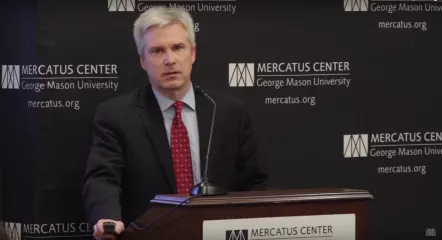- | Academic & Student Programs Academic & Student Programs
- | Government Spending Government Spending
- | Working Papers Working Papers
- |
Reforming the System of Review by Administrative Law Judges in Disability Insurance
A new study published by the Mercatus Center at George Mason University finds that part of the problem can be traced to a flaw in the SSDI program’s administrative structure: even if an applicant is twice denied disability benefits by the Disability Determination Service, he or she can often obtain benefits by appealing the rejection to an administrative law judge (ALJ). This study analyzes ALJ decisions using case studies, economic literature, descriptive statistics, and econometric analysis.
While the prevalence of disability in the US working-age population has remained flat, beneficiary enrollment in the Social Security Disability Insurance (SSDI) program has grown dramatically since the 1980s. As the SSDI trust fund heads toward insolvency—which it is projected to reach in 2016—policymakers would be wise to review and address such discrepancies.
A new study published by the Mercatus Center at George Mason University finds that part of the problem can be traced to a flaw in the SSDI program’s administrative structure: even if an applicant is twice denied disability benefits by the Disability Determination Service, he or she can often obtain benefits by appealing the rejection to an administrative law judge (ALJ).
This study analyzes ALJ decisions using case studies, economic literature, descriptive statistics, and econometric analysis. It finds that these varied sources—which employed varied methodologies—all reach a similar conclusion: serious failings by the ALJ system have led, on net, to large losses for taxpayers. This study concludes that a group of judges are deviating from the law to award unwarranted disability claims. It estimates that decisions over the past decade by these “outlier” judges will cost taxpayers more than $72 billion.
To read the study in its entirety and learn more about its authors, Mercatus Visiting Scholar Mark J. Warshawsky and Mercatus MA Fellow Ross A. Marchand, please see “Reforming the System of Review by Administrative Law Judges in Disability Insurance.”
SUMMARY
Many studies, using a variety of methodologies, have come to the same conclusion: a group of high-approval ALJs are systematically making poor decisions, at a high cost to taxpayers.
PREVIOUS EMPIRICAL WORK
- A 2014 report by the US Office of the Inspector General uses remand and reversal rates as a proxy for judicial decision quality and finds that low-approval ALJs have similar rates to the mean ALJ.
- The same report finds that eight of the twelve lowest-allowance judges “decided fewer cases than the average of their peers.” Thus, low-allowance judges are few in number and do not appear to decide more inaccurately than the average ALJ.
- High-approval ALJs, however, consistently exhibit poor decision-making. Internal Social Security Administration memos and other econometric analysis find that there exists an “iron triangle” between high approval rates, high decisional count, and poor decision quality.
- An econometric study finds that long-serving judges tend to be more lenient.
AUTHORS’ EMPIRICAL WORK
- Using two standard deviations both above and below the yearly mean ALJ allowance rate as a benchmark, the authors estimate that the decisions of “outlier” judges between 2005 and 2014 will cost US taxpayers more than $72 billion in likely unwarranted disability benefit awards.
- The authors conduct a regression analysis to determine the relationship between judges’ yearly allowance rates, the standard deviation of allowance rate over tenure, and decision volume. They find that “high-allowance” judges—unlike average or “low-allowance” judges—are consistently lenient year after year, and also decide more cases.
CONCLUSION AND RECOMMENDATIONS
The over-provision of disability benefits by outlier judges carries large economic stakes, both in monetary costs to taxpayers and in opportunity costs as capable workers detach from the workforce.
While recent public scrutiny and administrative changes have curbed some of the worst excesses, serious problems with the benefit claims appeals process remain. To restore sustainability and integrity to a troubled claims appeals process, the study recommends the following:
- Increase accountability by strengthening and expanding random reviews of ALJ decisions.
- Limit “gamesmanship” and reduce the number of claims by preventing anyone from applying for disability benefits more than once in a three-year period.
- Eliminate “on-the-record” decisions—decisions for cases that lack proper documentation—because these are very difficult for the agency to subsequently review for program eligibility in continuing disability.
- Cap at 500 the number of cases heard annually by each ALJ. This would reduce ALJs’ incentive to favor approvals in an attempt to rush through a backlog of cases, because judges must marshal more documentation for a denial than for an approval.
- End the “three hat” rule, according to which the judge is supposed to advocate for the claimant, advocate for the government (that is, the taxpayer), and render an unbiased judgment.
- End lifetime ALJ tenure and institute a 15-year term limit.
- Require the Social Security Administration by statute to conduct a statistically valid number of preeffectuation reviews of ALJ allowances.
To speak with a scholar or learn more on this topic, visit our contact page.


